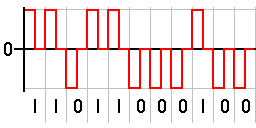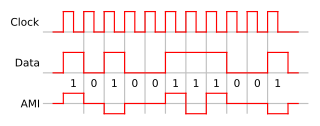
Code-division multiple access (CDMA) is a channel access method used by various radio communication technologies. CDMA is an example of multiple access, where several transmitters can send information simultaneously over a single communication channel. This allows several users to share a band of frequencies. To permit this without undue interference between the users, CDMA employs spread spectrum technology and a special coding scheme.
Modulation is defined as the process by which some characteristics like amplitude, frequency, and phase of a carrier signal are varied in accordance with a modulating wave.
In digital transmission, the number of bit errors is the number of received bits of a data stream over a communication channel that have been altered due to noise, interference, distortion or bit synchronization errors.

In telecommunication, a line code is a pattern of voltage, current, or photons used to represent digital data transmitted down a communication channel or written to a storage medium. This repertoire of signals is usually called a constrained code in data storage systems. Some signals are more prone to error than others as the physics of the communication channel or storage medium constrains the repertoire of signals that can be used reliably.
Modified AMI codes are a digital telecommunications technique to maintain system synchronization. Alternate mark inversion (AMI) line codes are modified by deliberate insertion of bipolar violations. There are several types of modified AMI codes, used in various T-carrier and E-carrier systems.

In telecommunication, a non-return-to-zero (NRZ) line code is a binary code in which ones are represented by one significant condition, usually a positive voltage, while zeros are represented by some other significant condition, usually a negative voltage, with no other neutral or rest condition.
Phase-shift keying (PSK) is a digital modulation process which conveys data by changing (modulating) the phase of a constant frequency carrier wave. The modulation is accomplished by varying the sine and cosine inputs at a precise time. It is widely used for wireless LANs, RFID and Bluetooth communication.

The T-carrier is a member of the series of carrier systems developed by AT&T Bell Laboratories for digital transmission of multiplexed telephone calls.
The E-carrier is a member of the series of carrier systems developed for digital transmission of many simultaneous telephone calls by time-division multiplexing. The European Conference of Postal and Telecommunications Administrations (CEPT) originally standardised the E-carrier system, which revised and improved the earlier American T-carrier technology, and this has now been adopted by the International Telecommunication Union Telecommunication Standardization Sector (ITU-T). It was widely used in almost all countries outside the US, Canada, and Japan. E-carrier deployments have steadily been replaced by Ethernet as telecommunication networks transition towards all IP.

Pulse-amplitude modulation (PAM) is a form of signal modulation where the message information is encoded in the amplitude of a series of signal pulses. It is an analog pulse modulation scheme in which the amplitudes of a train of carrier pulses are varied according to the sample value of the message signal. Demodulation is performed by detecting the amplitude level of the carrier at every single period.
In telecommunications, node-to-node data transfer is the movement of data from one node of a network to the next. In the OSI model it is handled by the lowest two layers, the data link layer and the physical layer.

Return-to-zero describes a line code used in telecommunications signals in which the signal drops (returns) to zero between each pulse. This takes place even if a number of consecutive 0s or 1s occur in the signal. The signal is self-clocking. This means that a separate clock does not need to be sent alongside the signal, but suffers from using twice the bandwidth to achieve the same data-rate as compared to non-return-to-zero format.
Amplitude-shift keying (ASK) is a form of amplitude modulation that represents digital data as variations in the amplitude of a carrier wave. In an ASK system, a symbol, representing one or more bits, is sent by transmitting a fixed-amplitude carrier wave at a fixed frequency for a specific time duration. For example, if each symbol represents a single bit, then the carrier signal could be transmitted at nominal amplitude when the input value is 1, but transmitted at reduced amplitude or not at all when the input value is 0.
Unipolar encoding is a line code. A positive voltage represents a binary 1, and zero volts indicates a binary 0. It is the simplest line code, directly encoding the bitstream, and is analogous to on-off keying in modulation.

In telecommunication, bipolar encoding is a type of return-to-zero (RZ) line code, where two nonzero values are used, so that the three values are +, −, and zero. Such a signal is called a duobinary signal. Standard bipolar encodings are designed to be DC-balanced, spending equal amounts of time in the + and − states.
In a digitally modulated signal or a line code, symbol rate, modulation rate or baud rate is the number of symbol changes, waveform changes, or signaling events across the transmission medium per unit of time. The symbol rate is measured in baud (Bd) or symbols per second. In the case of a line code, the symbol rate is the pulse rate in pulses per second. Each symbol can represent or convey one or several bits of data. The symbol rate is related to the gross bit rate, expressed in bits per second.
In serial communication of digital data, clock recovery is the process of extracting timing information from a serial data stream itself, allowing the timing of the data in the stream to be accurately determined without separate clock information. It is widely used in data communications; the similar concept used in analog systems like color television is known as carrier recovery.
In telecommunications, the hybrid (H-) ternary line code is a line code that operates on a hybrid principle combining the binary non-return-to-zero-level (NRZL) and the polar return-to-zero (RZ) codes.
Pulse-code modulation (PCM) is a method used to digitally represent analog signals. It is the standard form of digital audio in computers, compact discs, digital telephony and other digital audio applications. In a PCM stream, the amplitude of the analog signal is sampled at uniform intervals, and each sample is quantized to the nearest value within a range of digital steps.
Pulse-density modulation, or PDM, is a form of modulation used to represent an analog signal with a binary signal. In a PDM signal, specific amplitude values are not encoded into codewords of pulses of different weight as they would be in pulse-code modulation (PCM); rather, the relative density of the pulses corresponds to the analog signal's amplitude. The output of a 1-bit DAC is the same as the PDM encoding of the signal.





